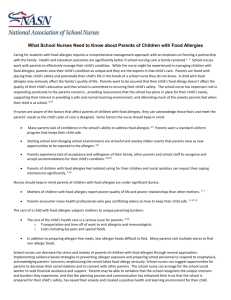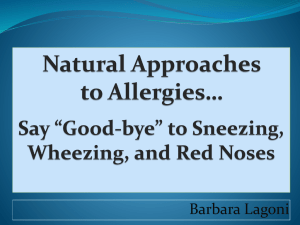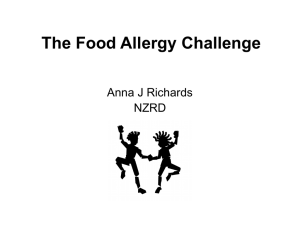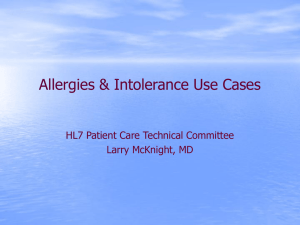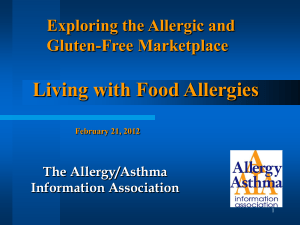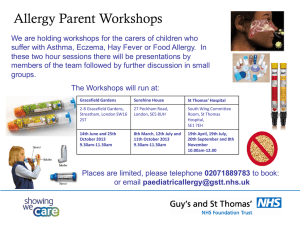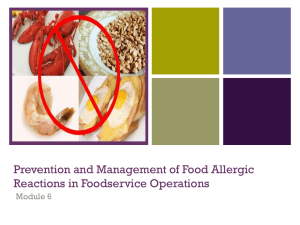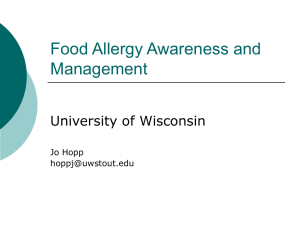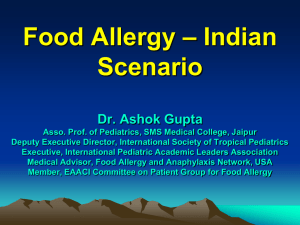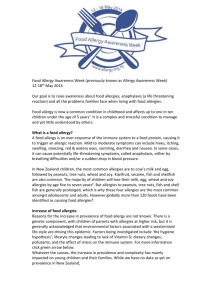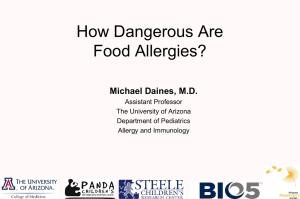Allergen Awareness - University of Maryland Dining Services
advertisement
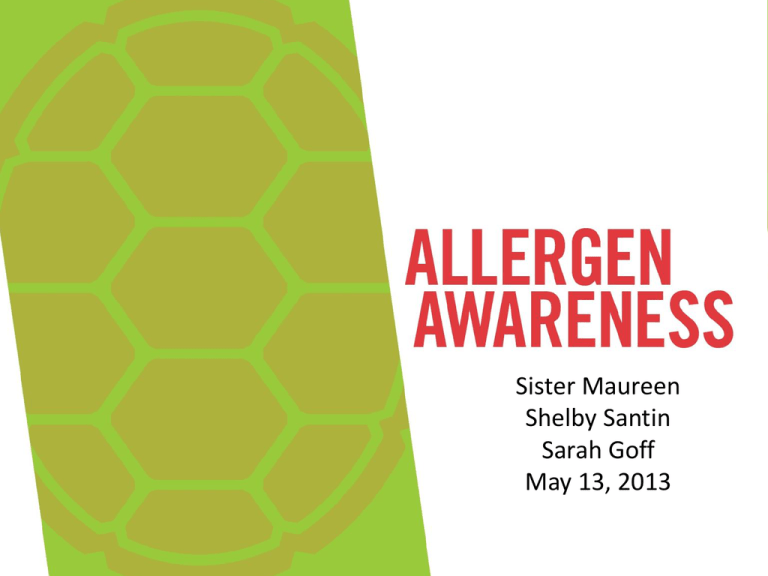
Sister Maureen Shelby Santin Sarah Goff May 13, 2013 What are Food Allergies? • The body perceives the certain food protein as foreign and harmful. • This produces a reaction to “protect” the body. • Some of these reactions could be lifethreatening. 8 Most Common Food Allergies • • • • • • • • Dairy Peanuts Tree nuts Eggs Soy Wheat Fish Shellfish Food Allergy Symptoms • Mild: Not life threatening – – – – – – – – – – – – Hives Eczema Redness of the skin or eyes Itchy mouth or ears Nausea or vomiting Diarrhea Stomach pain Nasal congestion or a runny nose Sneezing Slight dry cough Odd taste in mouth Uterine contractions Food Allergy Symptoms THESE REQUIRE MEDICAL ATTENTION • Severe: could be life threatening – – – – – – – – – Obstructive swelling of the lips, tongue or throat Trouble swallowing Shortness of breath Turning blue Drop in blood pressure (failing faint or confused) Loss of consciousness Chest pain A weak pulse Anaphylaxis Anaphylaxis • A serious allergic reaction that is rapid in onset and may cause death • Symptoms: – – – – – – – – – – – Tingling, itchiness, or metallic taste in the mouth Hives Difficulty breathing Paleness (from a drop in blood pressure) Loss of consciousness Swelling or itchiness of the mouth and throat Diarrhea Vomiting Cramps and stomach pain Confusion Weak pulse • Can occur between a few minutes to several hours after consuming an allergen How to Respond to Anaphylaxis • Call 9-1-1 immediately – Mention that someone is experiencing anaphylaxis • Remove the allergenic foods from the mouth and/or skin What are Food Intolerances? • The body is unable to properly digest the food protein • Symptoms are related to the digestive system • Symptoms include nausea, gas, cramps, abdominal pain, diarrhea, irritability, nervousness or headaches • Examples include lactose intolerance and gluten intolerance Gluten • Natural protein of wheat that gives dough its elasticity • Found in wheat, oats, rye and barley • The demand for gluten-free products has grown from 2004 to 2012 Celiac Disease • • • • Auto-Immune Disease Genetic Reaction to gluten protein Consumption of gluten could lead to ulcers, mal-absorption of nutrients and possibly death Where is Gluten Found? • • • • • • Baked Goods Sausages, pre-seasoned meats, deli meats Soups, sauces, gravies Salad dressing Seasonings Processed cheese spreads, powdered cheese mixed • Beer • Anything that contains flour Does it Contain Gluten? CONTAINS GLUTEN – – – – – – – – – – – – – – – – – – Barley Bulgur Einkorn Emmer Farina Farro Graham Kamut Oats (if not certified gluten free) Rye Spelt Triticale Breadcrumbs Cereals Durum flour All purpose flour Wheat protein Whole wheat berries – – – – – Semolina Pasta Soy sauce Glucose syrup Starch GLUTEN FREE – – – – – – – – Amaranth Buckwheat Corn Millet Quinoa Rice Tapioca Teff Food Allergy/Intolerance Stats • 18% increase in food allergies from 19972007 • An estimated 15 million Americans live with food allergies • Food allergies account for 30,000 hospital visits and 200 fatalities each year Prevention • No cure for food allergies, the only prevention from a reaction is avoidance. Food Labels Food Labels Food Labels Food Labels Food Labels Food Labels How to Read a Label for a Soy-Free Diet • Some unexpected ingredients that contain soy: – Edamame – Miso – Soybean oil – Soy sauce – Tofu – Textured vegetable protein – Soybean – Soy protein How to Read a Label for a DairyFree Diet • Some unexpected ingredients that contain milk: – – – – – – – – – Whey Casein Curds Custard Pudding Sour cream and sour cream solids Artificial butter flavor Caramel Chocolate How to Read a Label for an Egg-Free Diet • Ingredients that contain egg: – Mayonnaise – Meringue – Albumin – Eggnog – Pasta How to Read a Label for a PeanutFree Diet • Some unexpected ingredients that contain nuts: – – – – – – – – Artificial nuts Peanut oil Mandelonas Coconut Butternut Pesto (UMD Dining pesto is nut-free) Praline Pistachio • Peanuts are sometimes found in the following: – – – – – Egg rolls Enchilada sauce Marzipan Baked goods Chili How to Read a Label for a ShellfishFree Diet • Types of shellfish: – – – – – – – Barnacle Crab Crawfish Krill Lobster Prawns Shrimp • Ingredients that may contain shellfish: – Fish stock – Seafood flavoring – Bouillabaisse sauce Students with Food Allergies • Dining services is expected to provide allergen, processing and ingredient information • Eating from home can cause anxiety for those suffering from food allergies. • Students rely 100 percent on dining services for safe food options. Lesley Judgment • Lesley University was sued for not providing gluten-free options. • Rights protected under the American with Disabilities Act. • Food services need to provide “necessary reasonable modifications…..to fully enjoy the privileges, advantages and accommodations of its food service meal plan system.” Maryland and Food Allergies • One-on-one meeting with Sister Maureen Schrimpe • Allergy symbols on dining hall monitors • “To go” items are labeled for allergens and special diets • Allergy information online and through kiosks in the dining hall • Gluten-free menus available • Prepackaged allergen-free and vegan desserts now available! Causes of Food Allergy Reactions in Food Service 1. Poor Communication – Consumers may assume food ingredients from previous experience with food item – Allergy students want to feel normal and may feel uncomfortable asking questions – Servers need to take food allergy requests seriously Causes of Food Allergy Reactions in Food Service (cont.) 2. Hidden Ingredients • Sauces and mixed dishes • Recent product recalls due to undeclared food allergens • Ex: peanut butter in egg rolls Causes of Food Allergy Reactions in Food service (Cont.) 3. Cross-Contact of Allergens • Surfaces • Handlers • Plated food Cross-Contact • Unclean hands or gloves – wash hands before preparing a allergy-free meal • Splashed or spilled food- allergy free meal should be carried by itself from the kitchen • Trays- trays for allergy free meals should be washed with warm soapy water first • Garnishes- only chef or manager should garnish the plates • Refilled serving containers- wash all containers before refilling them with new foods Cross-Contact • AVOID using same utensils and equipment for allergen-free food preparation. • Even dust, crumbs or steam from a allergencontaining meal could contaminant an allergen- free meal! Alcohol wipes do not destroy allergen proteins; only hot, soapy water destroys these proteins! High-Risk Foods for Cross-Contact • • • • • Fried food Desserts Sauces Pastry Combination foods (stews and pot pies) **Advise food allergy consumers that these are high risk options. Front of the House • Refer food allergy student questions to a manager or chef • Be understanding, listen carefully • Have area designated where student can pick up food • Send student’s information to Sister Maureen for follow-up Back of the House • Inform guests of ingredients in unexpected places – Worcestershire sauce contains anchovies and/or sardines – Sweet and sour sauce may contain wheat and soy – Barbecue sauce may contain pecans • If you’re unsure about allergy information do not guess. Simply suggest another menu option for which you have information for Real Life Situation “I got a salad from Salad Sensations area, and I was watching the man making it very carefully, as usual. However, after taking a few bites of the salad, I found a chickpea in it. I called the incident to the attention of one of the managers, and he merely suggested I get something else to eat rather than taking steps to prevent this from happening in the future. I just wanted to let you know in hopes that the way this is handled can change in the future.” Spring 2013 Resources • FARE: http://www.foodallergy.org/home • http://www.nacufs.org/resourcesoverview • “Food Allergy Training Guide for College and University Food Services” The Food Allergy and Anaphylaxis Network, 2005. Thank You. Any Questions? Email me anytime at schrimpe@umd.edu

